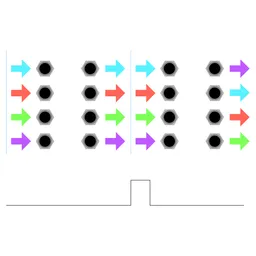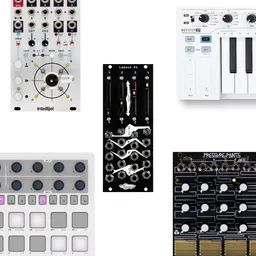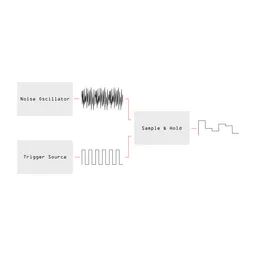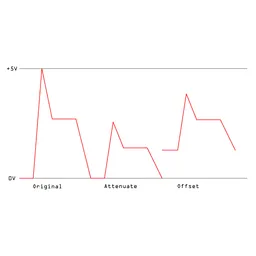Today, we continue our Getting Started series with a look at an important utility: the quantizer. Making a patch that sounds musical takes some doing, and quantizers play a big part in a melodic patch. Quantizers seem complicated on paper, but once you use one, they make a lot of sense. If this post is intimidating, don’t worry – they’re easier to use than they are to explain.
Some back story: What is control voltage?
In modular, we use control voltage, or CV, to automate things. Modules like sequencers, envelope generators, and LFOs create CV that we can use to move things around in our patch. For example, if we want to open a filter with an envelope, we do that by patching the envelope’s signal into the CV input on our filter. The patch cable carries the CV from the envelope generator to the filter and moves the cutoff parameter for us.
Many modules are designed to create CV, but there are also quite a few modules designed to process and modify CV: in fact, quantizers fall into that category.
What does CV mean for pitch?
CV is used to change the pitch of oscillators and change notes, too. Oscillators in Eurorack generally follow the one-volt-per-octave standard (often abbreviated as 1v/8va): a voltage increase of one volt at an oscillator’s pitch input will increase its frequency by an octave. This means that, to play in a traditional 12-note western scale, we need each voltage to be some multiple of 0.083 volts (1 volt / 12 notes), or one semitone, in order to play in tune. Put another way, every time we increase our voltage into the pitch input by 0.083 volts, we go up one note in the western scale.
But what if we increase our input by 0.0401 volts? Or decrease by 0.0603 volts? How do we make sure we map these changes perfectly to notes? That’s where quantizers come in!
What is a quantizer?
A quantizer is a utility generally used for pitch sequencing. It takes a CV input and translates it to a set of fixed voltages. This means that if you have a CV signal from something like an analog sequencer that isn’t outputting perfectly tuned voltages, you can use a quantizer to help make your patches play in tune. Quantizers often have settings for what notes they’ll quantize to, giving you options to change your patch to major or minor, for example, or even to user-defined scales in some cases.
You can also run a smooth signal like an LFO into a quantizer and it will output stepped voltages corresponding to pitches that will play in tune.

Quantization vs. tuning
An important distinction is the difference between tuning and quantization. They work together, but are not the same thing.
A quantizer makes sure that, if our oscillator is tuned correctly, all the other notes it plays are in tune as well.
Generally, quantizers will treat 0v, 1v, 2v, etc as corresponding to the note C (but check the manual just in case!). In order to make our oscillators play the notes our quantizer says it’s playing, we need to tune our oscillator to the quantizer. This can be done by patching your quantizer’s output to your oscillator’s pitch CV input, setting the quantizer to play a C, and tuning your oscillator with a tuner.
If you don’t do this, your sequences will be consistently off while playing back. Sometimes that might be okay – I often patch without paying a lot of attention to what exact note is where, but sometimes I want to make sure my whole patch is in, say, the key of D, so I’ll spend more time tuning everything first.
Quantizer module ins and outs
Generally, quantizers will have a CV input and a CV output per channel, and potentially a trigger input per channel as well. Quantizers vary greatly in complexity and features, but the concept is the same for any quantizer: voltage goes to the CV input, and comes out of the CV output quantized.
If your quantizer features a trigger input, that will function like a sample and hold: each time a trigger is received, it reads the CV input, and outputs the closest quantized voltage. That voltage won’t change until another trigger is received.
Quantizer configuration
Quantizers will also have configuration options to change their scales and notes. Some are simple, like the Doepfer A-156, with a switch for major or minor; others like Intellijel Scales let you type in a custom scale. A few exist that work with microtonal scales, too – since everything in Eurorack is based around voltages, it’s quite easy to break out of traditional tunings!
What is a quantizer used for in Eurorack?
The most common use for quantizers is with sequencers. Many digital sequencers intented for pitch sequencing have quantizers built in, but more traditional analog sequencers don’t: when I use an analog sequencer, I’ll have a quantizer like the Intellijel Scales patched up next to it to quantize its CV channels when I’m using it for melodies.
The patch for that is simple: a CV channel goes to the quantizer CV input, then the output goes to my voice. The trigger pattern from the sequencer is multed to the trigger input on the quantizer, and a second copy triggers my voice.
Once everything is patched, I set the sequencer steps to minimum and tune my oscillator to C using a tuner in my case. Then I can create a sequence and everything will play in tune.

Being modular, modules generally have multiple uses. Quantizers also can be used along with noise sources and a sample and hold to create random melodies.
By patching a noise oscillator into a sample and hold and then into a quantizer we can generate random melodies. Each time we trigger the sample and hold we’ll get a new random note, which can be a great way to run a generative patch. This can create a wide range of pitches, so an attenuator can be used on the noise source to limit its range, too. If our quantizer has a trigger input, it will act as a sample and hold by itself, creating an even simpler patch.

When do you not need a quantizer?
Many patches won’t require a standalone quantizer module. Melodic digital sequencers often have quantized pitch outputs, so you may not need to run their CV outs through an additional quantizer for your patch to play in tune.
I’ve skipped the quantizer and tuned things by ear in a few analog sequencer patches and it offers some interesting flexibility, especially if you like tunings outside of tradition… just be prepared to spend some time making tiny adjustments.
For advanced patchers: Troubleshooting reality and dealing with latency in quantization
Sometimes, physics can get in the way of our patches. It’s common for there to be a slight difference in timing between gate and CV signal changes, especially when dealing with signals from separate sources. This can cause issues when using triggered quantizers, as sometimes they’ll be triggered just slightly before our sequencer changes its CV output. This can cause notes to be played incorrectly, or our pitch CV to be a step behind our trigger sequence.
This can be solved with a gate delay module: some quantizers have this functionality built in, but if yours doesn’t, they’re available as separate modules as well (with some creative patch functionality outside of this particular use as well).
Run your trigger sequence through the delay, and mult a copy to your quantizer and your voice. Adjust the delay time to the lowest it can be while still quantizing correctly, and your patch should work how you’d expect it to without much noticeable difference in timing.

What are some examples of quantizers?
Here are just a few modules that can perform some of the functions we've been chatting about. There are always lots of choices in modular!
Intellijel Scales: A simple quantizer with easily customizable note settings.
Doepfer A-156 Quantizer: A dual-channel quantizer with simple scale settings.






